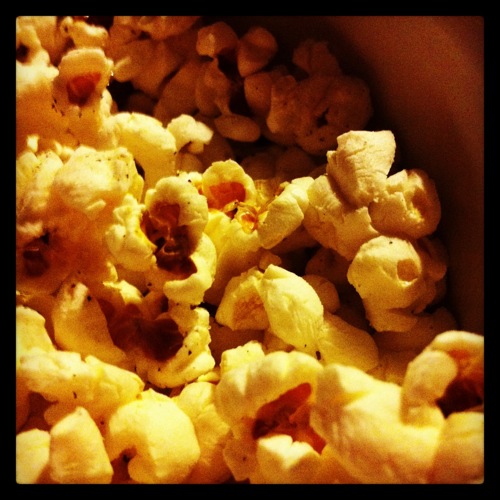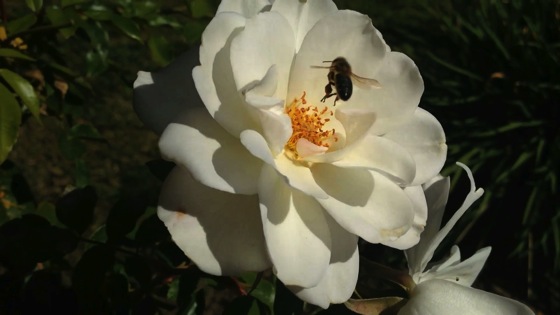Honeybee
It took some time to make peace with honey bees. I grew up with yards that were more clover than grass, so summer days often involved accidentally stepping on bees in the yard while we played. Along with that we had nasty mud dauber wasps that seem to sting you for no other reason than just being there. Add to that the ground dwelling bees that would sometimes well up when you were mowing the yard and it tended to make you a bit scared of anything that flew and sort of looked like a bee or wasp.
Follow DouglasWelch in Instagram
I have learned over the years, though, how to identify a honey bee (and our somewhat bumbling huge carpenter bees) here in California. I am often showing people the difference between the gentle honey bee and the aggressive food scavenging yellow jacket wasps. I am always telling people that a honey bee doesn’t want to sting you because stinging means that it will die. Wasps, on the other hand, can (and do) sting multiple times without too much ill effect.
I have walked through clouds of honeybees who have been naturally swarming near trails and such and find them a docile, if acoustically intimidating, companion. Their buzzing can get quite loud in mass and I think this scares a lot of people, too.
I don’t have room for honeybees here in my yard, but I think in different circumstances I might become a beekeeper, tending my flock for the benefit of us both.
Honey bees (or honeybees) are bees of the genus Apis, primarily distinguished by the production and storage of honey and the construction of perennial, colonial nests fromwax. Honey bees are the only extant members of the tribe Apini, all in the genus Apis. Currently, only seven species of honey bee are recognized, with a total of 44 subspecies,[1]though historically, from six to 11 species have been recognised. Honey bees represent only a small fraction of the roughly 20,000 known species of bees. Some other types of related bees produce and store honey, but only members of the genus Apis are true honey bees.
The study of honey bees is known as apiology.
Honey bees appear to have their center of origin in South and Southeast Asia (including the Philippines), as all but one (i.e. Apis mellifera), of the extant species are native to that region. Notably, living representatives of the earliest lineages to diverge (Apis florea andApis andreniformis) have their center of origin there.[2]
The first Apis bees appear in the fossil record at the Eocene–Oligocene boundary (23–56 Mya), in European deposits. The origin of these prehistoric honey bees does not necessarily indicate Europe as the place of origin of the genus, only that it occurred there then. A few fossil deposits are known from South Asia, the suspected region of honey bee origin, and fewer still have been thoroughly studied.
No Apis species existed in the New World during human times before the introduction of A. mellifera by Europeans. Only one fossil species is documented from the New World, Apis nearctica, known from a single 14-million-year old specimen from Nevada.[3]
The close relatives of modern honey bees—e.g. bumblebees and stingless bees—are also social to some degree, and social behavior seems a plesiomorphic trait that predates the origin of the genus. Among the extant members of Apis, the more basal species make single, exposed combs, while the more recently evolved species nest in cavities and have multiple combs, which has greatly facilitated their domestication.
Most species have historically been cultured or at least exploited for honey and beeswax by humans indigenous to their native ranges. Only two of these species have been trulydomesticated, one (A. mellifera) at least since the time of the building of the Egyptian pyramids, and only that species has been moved extensively beyond its native range.
Today’s honey bees constitute three clades.[1][4] — Wikipedia
More information on Honey bees:
Bee books, information and more on Amazon.com
- Acanthus
- Amaryllis
- Apricot (Prunus armeniaca)
- Aspen
- Azalea
- Banana
- Bonsai
- Bougainvillea
- Brugmansia
- Butterfly (Lepidoptera)
- California Flannelbush (Fremontodendron californicum)
- California Poppy (Eschscholzia californica)
- Calla Lily (Zantedeschia aethiopica)
- Campsis radicans
- Castor Bean (Ricinus)
- Caltapa
- Chives (Allium schoenoprasum)
- Clematis
- Camellia
- Currant (Ribes)
- Dahlia
- Datura
- Japanese Cherry (Prunus serrulata)
- Daffodil (Narcissus)
- Dietes (Fortnight Lily)
- Dudleya
- Echinacea
- Ecualyptus
- Ficus benjamina
- Freesia
- Fungi
- Gerbera Daisy
- Grape (Vitis vinifera)
- Helianthus (sunflower)
- Hibiscus (Malvaceae)
- Iris
- Jacaranda mimosifolia
- Joshua Tree (Yucca brevifolia)
- Kniphofia “Red Hot Poker”
- Lantana
- Lavender (Lavendula)
- Kousa Dogwood (Cornus kousa)
- Magnolia x soulangeana (Saucer Magnolia/Tulip Tree)
- Mandevilla
- Magnolia Grandiflora
- Marigold (Calendula officinalis)
- Matilija Poppy (Romneya)
- Morning Glory (Convolvulaceae)
- Nandina
- Oleander (Nerium)
- Orange
- Orchid from the Southern California Spring Garden Show 2013
- Oriental Poppy (Papaver orientale)
- Polygonatum (Solomon’s Seal)
- Paperwhites
- Pineapple (Ananas comosus)
- Primula (Primrose)
- Queen Anne’s Lace (Daucus carota)
- Rosa ‘Mikado’
- Rudbeckia
- Salvia
- Squirrel
- Star Jasmine (Trachelospermum jasminoides)
- Succulents
- California Sycamore (Platanus racemosa)
- Sweet Potato (Ipomoea batatas)
- Tomato
- Water Lily (Nymphaeaceae)
- Wisteria






